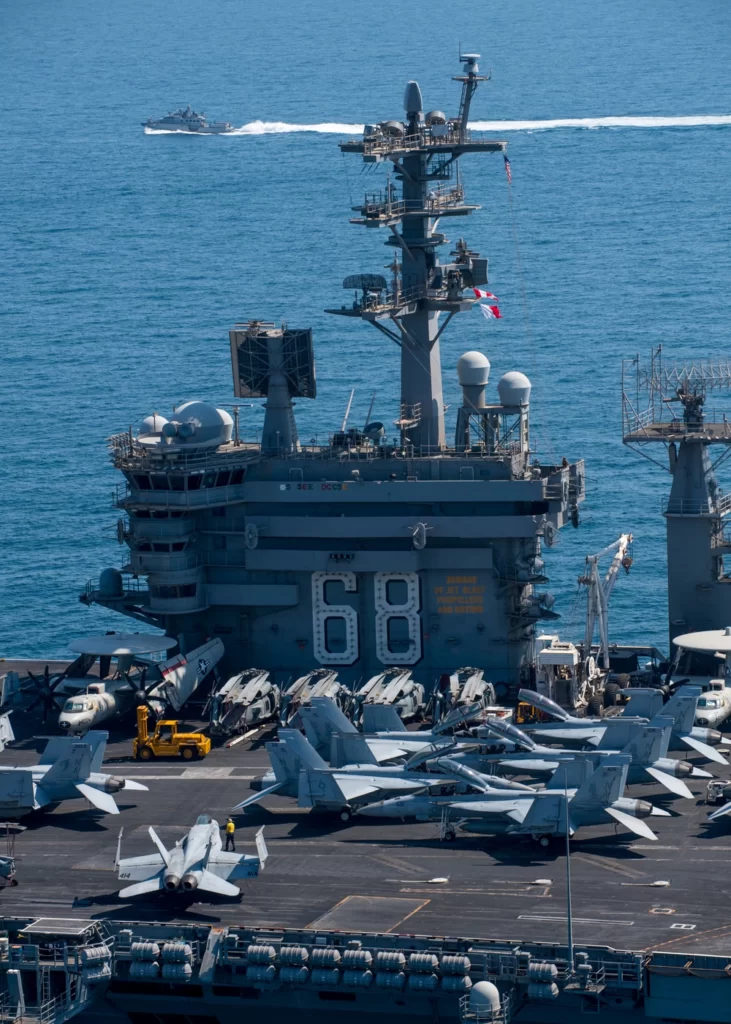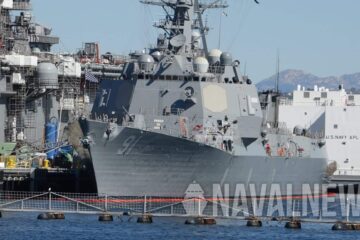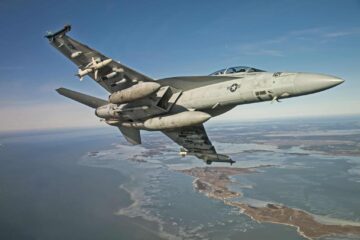At the USNI/CSIS “Maritime Security Dialogue: Force Design 2030 and Marine Corps Modernization Efforts” held on May 4, 2022, LTG Karsten Heckl from the USMC discussed the status of Force Design 2030 to a LIVE audience and those online.
Naval News asked the following question:
Naval News: The US Navy wants to do away with large amphibs [stop production] such as the LPDs and small boats such as the Mark VI Patrol Boat and Patrol Coastals. How would these retirements affect Marine Corps littoral and amphibious warfare, and can the Marines convince the US Navy to field both large ships and small boats in the future?
LTG Heckl: “I don’t think the Navy intends to get rid of `Big Deck Amphibs.’ There have been a lot of external pressures that are bearing on the United States Navy, and the USMC is a department of the U.S. Navy. There are a lot of external factors bearing down right now that have caused the dip in Readiness. We’ve overused assets; we ride these things hard and put them away wet. We did that over the 20 years in Afghanistan and Iraq with airplanes and we were all befuddled when airplanes weren’t ready. Well, there is a decision-consequence. You make decisions, and over-utilize deferred maintenance, and this is what you end up with. So, I don’t think the Navy intends to get rid of those and I think the traditional L-class Amphibs are vital to our ability to respond both to crisis and if there was a major conflict. The ability to [build] aggregate fleets and the number of L-class Amphibs presents the nation with an option that no other can.
“The small boats we’re exploring those within Force Design. So Littoral Maneuver is a big piece of Stand-in Force and we’ll be in any theater, so we’re looking at `What does Light Armed Reconnaissance (LAR) look like next?’ `What would LAR look like in the Indo-Pacific?’ `Would it be a LAV-25 vehicle…or is it a boat?’ `Is it a fleet of unmanned boats…and some vehicles?’ We’re determining that right now.”
Naval News and Author’s Comments
“…I’d love to be able buy as many ships as they can generate, but it’s got to be a navy we can afford, right? So that has always been my message with respect to Readiness and modernization and capacity. It’s going to be a navy that we can sustain.”
Admiral Michael Gilday, U.S. Navy CNO
U.S. Navy’s Chief of Naval Operations (CNO) Admiral Michael Gilday said this at the WEST 2022 conference held mid-February on the possibility of the U.S. Navy buying both the new FFG 62 Constellation-class frigates and Light (mini) Destroyers. CNO Gilday’s statement could also apply to the U.S. Navy’s attitude toward sustaining the Mark VI Patrol Boats and future large and small vessels. Naval News wrote on 30 January 2021 regarding Surface Navy Association 2021 in how the USMC views the Mark VI Patrol Boats.
“But Major General Tracy King from the USMC said that the twelve MK VIs `Were very expensive to maintain.’ (The MK VI use two diesel engines to power waterjets instead of shafts and propellers).
“Major General King also mentioned that in wargaming scenarios against peer nations, the MK VIs were deemed not really needed (given their small size and limited missile firepower), but King did reserve judgment for the incoming Biden Administration and said that he will wait for VADM Jim Kilby, USN, Deputy Chief of Naval Operations for Warfighting Requirements and Capabilities, N9, to make the Requirements decision on the Mark VI Patrol Boats (because originally 48 MK VI PBs were on order) and on the future of new small U.S. Navy boats.”

For speculative discussion purposes, Naval News has addressed the height differences between the Mark VI and small patrol boats compared to larger Navy warships in that the height differences may expose security gaps that only small boats can counter and close. This would be especially true with slower amphibious ships (high value asset security) that cannot dash to chase down and shoo away smaller fast attack craft; that is the job of the small fast patrol boats.
In the above photo, notice the vast height differences of the Mark VI docked alongside the Landing Platform Dock (LPD) Amphib. At maximum gun and weapons system depression of the LPD (the LPDs are armed with two Mark 46 30mm gun systems and two Mark 31 Mod 1 RIM-116 21-cell Rolling Airframe Missile (RAM) launchers), the LPD would be literally defenseless at extreme close quarters except for the personal weapons carried by the crew (M4 carbines, shotguns, handguns, and handheld machine guns) if adversarial small boats were to get right alongside the LPD. And that is what happened with the USS Cole bombing where a small skiff steered right alongside the Arleigh Burke destroyer before detonation.
The task of keeping these small, fast, and stealthy adversary attack crafts away would fall to the U.S. Navy’s fast and heavily armed Patrol Boats. These Patrol Boats fill in the gaps in radar coverage amongst the waves and dash around investigating suspicious and unidentified contacts as evident in the photo of a Mark VI Patrol Boat sprinting as an inner screen for a large nuclear-powered aircraft carrier. U.S Navy Patrol Boats do operate in the open seas and the littorals.
Armed with one or two Mark 38 MOD 2 25mm autocannon(s), remotely-operated .50cal M2HB heavy machine guns, and pintle-mounted M2HB or M240 medium machine guns, the Mark VI Patrol Boats are heavily armed for their size with a crew of 10 and up to eight passengers, usually the Visual Boarding Search and Seizure (VBSS) Team (or in some cases, USMC).
No matter what the fate of the Mark VIs (The U.S. Navy stated that the Mark VIs will be divested and will most likely be sold to foreign navies), the U.S. Navy is not getting rid of the Patrol Boat class, just possibly the Mark VIs. Thus, the argument would be: Would the new Patrol Boat replacements have the same capabilities as the Mark VIs? That is a question for open speculation, discussion and debate.
Naval News contacted the U.S. Navy’s Naval Sea Systems Command (NAVSEA) in mid-May 2022 inquiring about any new Patrol Boats. NAVSEA replied stating that the 40-foot Patrol Boat, built by Metal Shark, is being acquired. One key feature missing with the 40-foot (12.19 meters) Patrol Boat (the Mark VI is 85 feet/25.90 meters long) are the two Mark 38 MOD 2 25mm autocannons, replaced with .50 caliber M2HBs. Naval News will cover the 40-foot Patrol Boat (NAVSEA nickname 40 PB) in more detail in another story—stay tuned.

The small width of the Mark VI Patrol Boat means that several can be housed inside the well deck of a LPD with the LPD acting as “Mothership” to the Mark VI. Thus, the LPD “Mothership” can disgorge 45+ knot Mark VIs to combat militia fishing fleet, militarized civilian ferries, and pirate boats that may “swarm attack” the larger naval vessels.

“I think that once we really put our heads to it and think about the options of manned capabilities and unmanned capabilities now…and you start to think, `well deck.’ You know when the well deck is closed up, you can’t really see what’s inside it. So, the value here really is if you’re an adversary, wow, you can see an amphib ship there, you don’t know what’s inside it. It could be collection systems; it could be lethal systems; it could be surface-to-surface connectors that can project the force ashore, and you have no idea looking from the outside in.”
General David Berger, Commandant, USMC, regarding the well deck on amphibious ships at EWC 2022.
What Does USMC Light Armed Reconnaissance Look Like from a Boat?
LTG Heckl said that the USMC is working to determine what “Light Armed Reconnaissance” looks like. Here are a few possibilities as presented in photos of Marines aboard Mark VI Patrol Boats conducting live-fire training exercises with FIM-92 Stinger Short-range Air Defense Missiles (SHORAD) and FGM-148 Javelin Anti-Tank Guided Missiles (ATGM). Stingers and Javelins have a range in excess of 3 miles/5 kilometers.
The possible pairing of the fast and mobile Patrol Boat with the Marines aids in Distributed Maritime Operations (DMO) for Distributed Lethality. The key benefit is that the Patrol Boat presents such a small target that large adversarial Anti-Ship weapons systems meant to attack warships would be hard-pressed to fire and expend resources and ammunition on targets that are so cheap, small, fast, numerous, and seemingly low-threat and unimportant (just like a militia fishing or Mosquito fleet).

If the Mark VIs are indeed divested, a potential replacement could be the Metal Shark Long-range Unmanned Surface Vessel (LRUSV, not to be confused with the Vertical Launch System “Shooter” Large Unmanned Surface Vessel (LUSV). The small LRUSV can make up for its lack of Mark 38 25mm autocannons with Loitering Munitions for Long-range Precision Fires (LRPF).

Kelly Flynn, Public Affairs Specialist, USMC Systems Command, Office of Public Affairs & Communication, replied to a Naval News inquiry on May 11, 2022 regarding the current status of integrating Loitering Munitions on the Metal Shark’s Long-Range Unmanned Surface Vessel (LRUSV).
“The Marine Corps’ is continuing the integration and testing of organic precision firing capabilities on LRUSV and working toward an early operational assessment.”
Kelly Flynn, USMC Systems Command, May 11, 2022
Naval News will continue investigating and reporting on the U.S. Navy and Marine Corps’ quest to balance the forces of having and providing “Big Deck Amphibs” and small fast boats for the naval forces.







